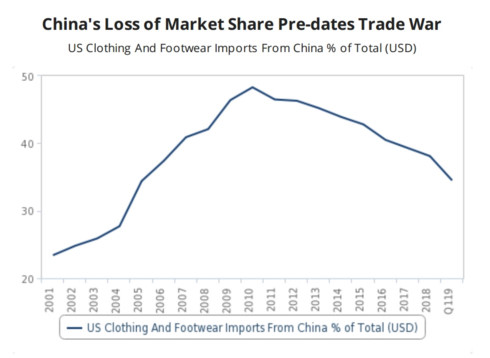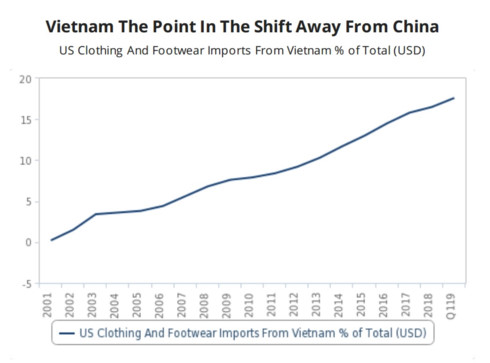 |
|
Source: Trade Map, Fitch Solutions
|
China sourcing decline trend
The macro-research subsidiary Fitch Solutions quoted data as showing that China is the main source for US apparel imports, accounting for 38 per cent of total clothing and footwear products entering the US last year.
However, China’s market share in the US textile supply chain has been steadily decreasing since 2010, when it accounted for almost half (48 per cent) of US imports of clothing and footwear. Rising wages in China, with cheaper labour costs seen in other major textile producing countries, have been a key driver of the downward trend.
The US-China trade war is serving to accelerate the trend as quarterly data shows that in the first quarter of 2019, China’s clothing and footwear imports to the US dropped by 1 per cent on year and accounted for 34.5 per cent of the total.
The risk of tariffs on apparel imports from China to the US has existed since mid-2018, but the threat looked to have lessened in June 2019, when at the G20 Summit in Japan, President Donald Trump stated that a move toward placing tariffs on US$300 billion worth of Chinese imports, including clothing and footwear, was on hold.
However, on August 2, President Trump announced that the US will press ahead with a 10 per cent tariff on US$300 billion worth of Chinese imports, to come into effect on September 1. The tariff rate of 10 per cent is lower than the originally planned 25 per cent, but this will not alleviate. President Trump has warned that the tariff level could be lifted to 25 per cent and beyond.
Ongoing diversification strategies of US retailers
Major US fashion retailers have been steadily decreasing their supply-chain exposure to China in recent years, but this has taken on greater urgency as trade war risks have come to prominence, Fitch Solutions analysts told VOV Online.
In light of the planned 10 per cent tariff hike and the threat of further tariff increases, the analysts expect US fashion retailers to revisit their sourcing, with the potential for companies to seek to decrease their exposure to China even further, and to accelerate their existing diversification timelines.
For instance, Under Armour said that it plans to slash the percentage of its products sourced from China from 18 per cent in 2018 to 7 per cent by 2023.
Another major US fashion retailer GAP Inc has been diversifying its supply chains. In 2016, 25 per cent of the retailer’s products were manufactured in China, but the ratio has shrunk to 21 per cent in 2019. “We have been mitigating sourcing out of China for the last several years and we will continue to do this responsibly going forward,” Art Peck, the company’s president and CEO, stated in June 2019.
US retailers’ sourcing diversification strategies will focus on ramping up production from manufacturing hubs where they have already started to build up their exposure. Retailers could therefore leverage current networks and benefit from existing knowledge of manufacturing regulations, labour costs and logistics.
The research entity cited Gap Inc as an example to highlight that diversification options for the company to decrease its reliance on China include Vietnam, India, and Indonesia, which respectively account for 20 per cent, 14 per cent and 9 per cent of the firms’ sourcing factories by April 2019.
Vietnam to be key beneficiary
Vietnam is set to be a key beneficiary of the diversification process. The country is ranked second in the US’ total clothing and footwear importers, jumping from just 0.2 per cent of the imports in 2001, to 16.5 per cent in 2018.
Turning Vietnam into a textile manufacturing powerhouse has been aided by the fact it offers cheaper labour in comparison to China (minimum wage level in Vietnam stood at US$160.7 per month in 2017, much lower than China’s US$311.5).
 |
|
Source: Trade Map, Fitch Solutions
|
Vietnam holds the second position behind China as a sourcing point for US retailers, with a number of fashion companies already utilizing their textiles factories, thus making the Southeast Asian country an obvious diversification option.
Data for the first quarter of 2019 indicates that this view is starting to play out, with the US import of clothing and footwear sourced from Vietnam increasing by 13 per cent on year, and its share within US fashion imports rising to 17.6 per cent.
Other countries where US fashion retailers already have a sourcing presence, albeit much smaller, would also witness a ramp up in orders from the US.
Fitch Solutions analysts have kept closer watch on countries within the US’ top 20 textiles sourcing pool, which have seen their increasing role in US fashion imports over the 2001-18 period and have recorded annual growth in demand in the first quarter of 2019.
Based on these calculations, they believe that Vietnam along with other countries stands to benefit the most from US retailers’ diversification away from Chinese textiles factories.
Fitch Solutions/VOV
 Vietnam’s apparel industry will be a key beneficiary from the ongoing US-China trade war and the subsequent diversification strategies of US retailers, a research entity of Fitch Group has forecast." itemprop="description" />
Vietnam’s apparel industry will be a key beneficiary from the ongoing US-China trade war and the subsequent diversification strategies of US retailers, a research entity of Fitch Group has forecast." itemprop="description" />